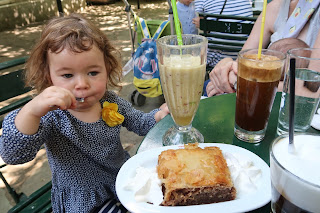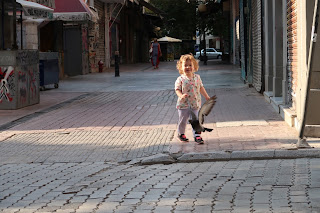So we came up with a backup plan, and walked to what our guidebook said was one of the nicest museums in all of Europe. However, when this is the “stroller entrance”, we figured that this wasn’t a place to take your two year old.
I’m sure the museum is lovely, but our trip budget doesn’t have room for a small collection of priceless artifacts. Even watching her drink from a $3 glass makes me nervous.
Back up plan #3. When all else fails, there’s always slides and swings!
But it was hardly a sacrifice. By this point, Aimee and I were craving a coffee, and it turns out that there’s a great little cafe on the national garden grounds.
I’ll have a cappuccino, hold the espresso.
The baklava alone would be worth a return flight. Seriously.
We strolled around the park a bit more after we finished our coffees, and were pleasantly surprised that the park also has a little open-air zoo in it. Strong work, Athens.
After another great nap, we spent the rest of the afternoon following our noses and taste buds. This city really can’t miss on the food. It’s unbelievable.
And this is the face a toddler makes when she has her first* ice cream.
*Aimee and I have chosen to lie to ourselves about what our daughter eats with her grandparents.
As we got ready for bed last night, we repeated our positive affirmations, “We’re going to the Acropolis tomorrow. We’re going to the Acropolis tomorrow.” Our friends Nona and Grael warned us that they didn’t make it to the Acropolis with their one year old during their time in Athens, and we totally understand why. It’s a daunting hike, even without a toddler. And the road to the Acropolis is lined with cafes and pastry shops tempting you to cut the hike deliciously short.
This morning, our kids thoughtfully woke us up a bit before the alarm clock. They knew we’d need an extra push to get moving, or else the heat and baklava would convince us to scrap our plans a third time.
Mimi and I took our apartment’s charming elevator down to the street for an early morning coffee run while Aimee nursed Quinn.
I’ve picked up enough Greek to order a couple of cappuccinos (thanks, Rosetta Stone), but nowhere near enough to understand what the barista said back to me. I was flattered that he thought my Greek was passable, and I didn’t want to ruin the illusion by raising my eyebrows in the international sign of, “Your language is very difficult.” I just hoped that he didn’t say something like, “Don’t drink these, they’re poisonous.”
Our walk through Athens on a sleepy Sunday morning was quiet and peaceful. All of the shops were closed, and aside from the rumble of an occasional motorbike or the clinking of dishes at a cafe, the streets were quiet.
This was yet another historic building that stands flanked by the growing city around it.
Navigating this city is pretty easy, since the Acropolis in the southwest corner is visible from nearly any point in central Athens.
As you get closer to the Acropolis, you start walking past layer after layer of ancient history. I’m sure that people who come here without children would be able to tell you what these buildings are.
But knowing that I’d have exactly 2.7 seconds to read any informational placard on this trip, I did a bit of homework ahead of time. For anyone even remotely interested in Greece or the origins of Western drama/music/philosophy/comedy/etc, I can’t recommend this book highly enough. It was a fascinating read. Aimee read the intro and felt like she was in AP European history again, but the rest of the chapters weren’t as textbooky as they could have been. I’ll probably go into a bit more detail about the history in a separate post, but a quick timeline might be helpful for some context of the Acropolis.
1300 BC - Earliest evidence of an organized society in the region.
800 BC - Earliest and best examples of Ancient Greek storytelling (think the Odysey and the Iliad).
600-300 BC - Peak of Ancient Greece, anchored by a very poweful Athens society. Democracy is born, and Western civilization is advanced to an almost unfathomable degree.
~400 BC - Acropolis complex is built to honor Athena, patron goddess of Athens. Buildings serve as political, religious, and military hub of the city.
300s BC - Macedonians take over leadership and expansion of the Greek empire. Alexander the Great (and his father before him) expand the empire to a scale never before seen in the ancient world.
200s BC - Strained from rapid expansion, the empire collapses after the death of Alexander the Great. Decades of war between his lieutenants carve up the map, and leave several Greek-inspired mini-empires from Egypt to India.
200 BC to 300s AD - Divided intellectually, culturally, and militarily, the Greek world gets absorbed into the expanding Roman Empire.
300s AD to 1800 AD - Early Christians adopted and rewrote many Greek texts, changing their philosophy and conclusions dramatically. Even more texts were outright destroyed by wave after wave of invaders.
1800 AD to Present - Some original texts are rediscovered, and the depth and diversity of early Greek thought is becoming better understood.
It really is fascinating, even to a very casual observer like myself. But back to the hike. Being that this was our third attempt at the mountain, Aimee had plenty of time to check the travel-mom blogs. Universal consensus was that strollers weren’t worth the trouble on the ancient cobblestone roads. So Mimi went on my shoulders, and Quinn went in Aimee’s sling. We set out for the mountaintop, and got a stunning view along the way.
Once we got to the top, Mimi went more from adorable shoulder decoration to tour guide.
Even the apex of Western Civilization can only hold the attention of a two year old for so long. The kitties, bathrooms, and barricades that she didn’t even have to duck under were far more appealing.
No, Dada, I’m looking for the pottie.
But for the rest of us (well, actually two of the rest of us), it was nothing short of breathtaking.
Hey Mimi. Quick! Turn around! It’s one of the bedrocks of modern civilization!
Sure, Dada, but have you seen this dirt?!
But in all fairness, she probably just unearthed another paradigm shifting discovery about the ancient world. As you can see from the cranes and scaffolding behind us, the Acropolis complex is a living archeological site. And it’s not just building upkeep. Like everywhere else in Athens, there are layers upon layers of history in the ground here. And not just the Greeks, the Persians, Mycenaeans, Romans, and Ottomans have all left their mark here.
After we made our way through the Acropolis grounds, our tour guide led us back down the hill.
It was looking dicey for a bit, but we’re so glad we made the trek. Mimi did great, and the site really is an incredible piece of living history that we were honored and humbled to be able to walk through.
Now back to reality. Our early wake up meant that we were done with our day’s activity by 10. And long gone are the days where we can spend the afternoon with a beer and a book.
But you know what does keep a toddlers attention? The choo choo!
A €1.60 metro ticket is, far and away, the best value in children’s entertainment in all of Greece.
And of course, there’s always the park!
We decided to branch out in a different direction for our walk to dinner. It inadvertently brought us through a rougher part of Athens. It wasn’t the kind of place where you feel like you’re in any immediate danger, but you’re definitely paying attention to which pocket your wallet is in. It was a good reminder that despite the history and charm, Athens, like the rest of Greece, is just barely recovering from multiple parallel economic crises. It’s very easy to visit this place without seeing much evidence of that.
But like most rough-seeming parts of most cities, they’re generally harmless. We had a delightful dinner, and definitely stuck with our more familiar paths home, much to the chagrin of the pigeons on the street just south of us.
Sorry guys, she’ll be out of here tomorrow.



























